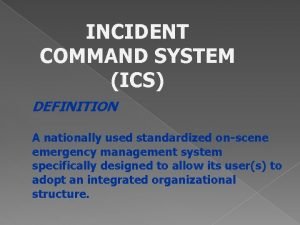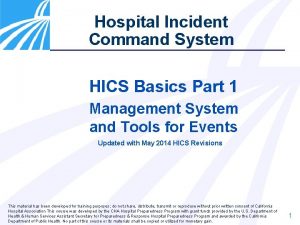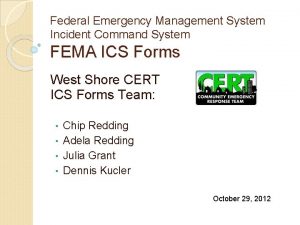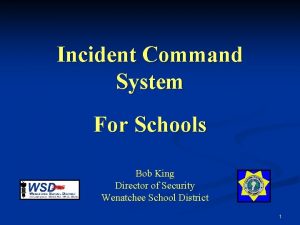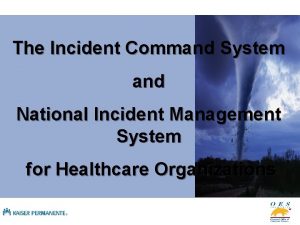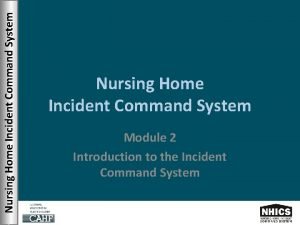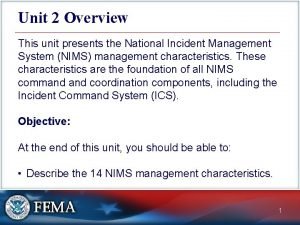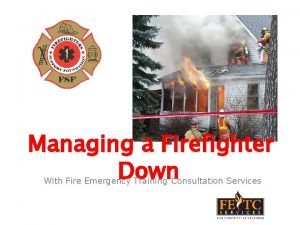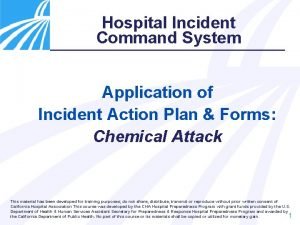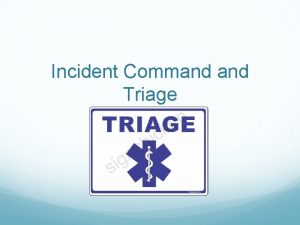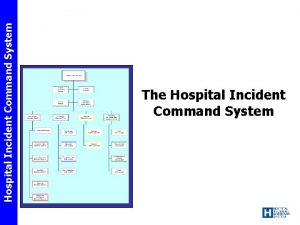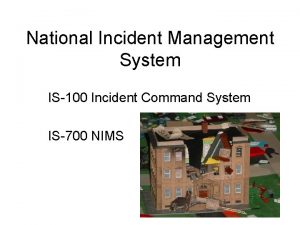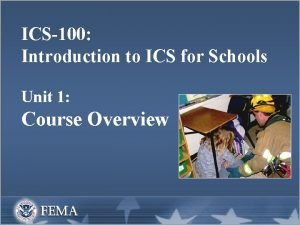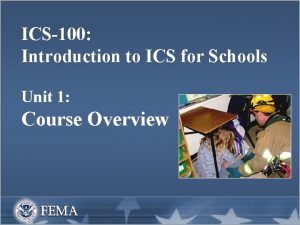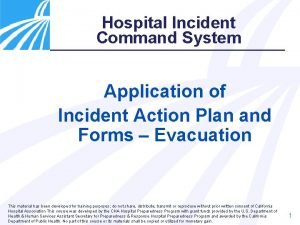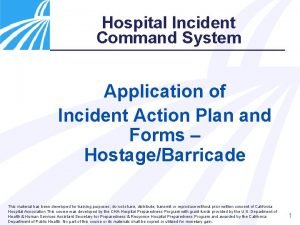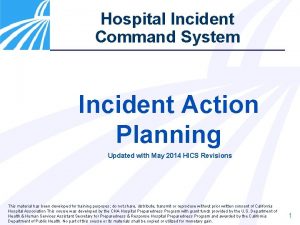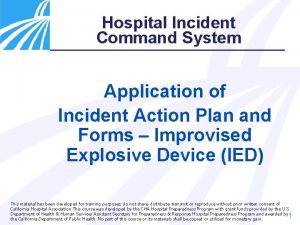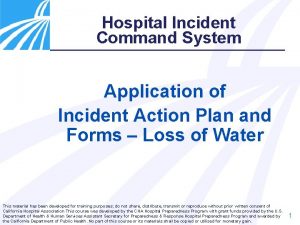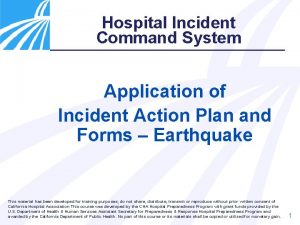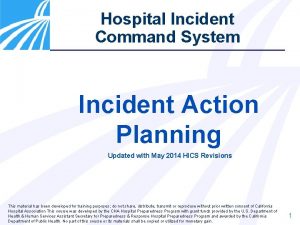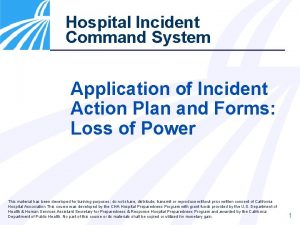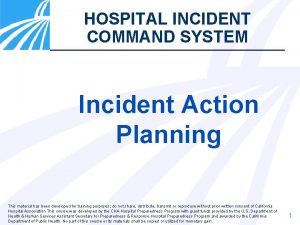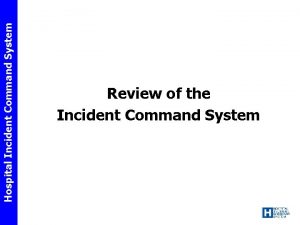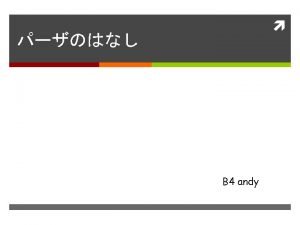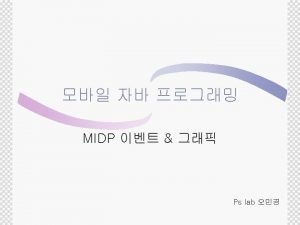INCIDENT COMMAND SYSTEM ICS100 INTRODUCTION TO THE INCIDENT








































- Slides: 40

INCIDENT COMMAND SYSTEM ICS-100 INTRODUCTION TO THE INCIDENT COMMAND SYSTEM FOR FEDERAL WORKERS

ICS-100 Objectives At the end of this lesson, you should be able to: l Describe how ICS became the standard for emergency management across the country. l Provide examples of how ICS is interdisciplinary and organizationally flexible. l Identify five major management functions. l Determine whether the principle of span of control has been applied properly in a scenario.

ICS-100 Objectives (cont. ) l Describe the purpose of unique position titles in ICS. l Determine the roles and responsibilities of the Incident Commander and Command Staff. l Describe the roles and responsibilities of the General Staff. l Determine, when it is appropriate to expand contract the ICS organization. l Identify the facilities used in ICS.

Types of Incidents l l l l Planned events Fire, both structural and wildfire Hazardous materials incidents Search and rescue missions Oil spills Natural disasters Terrorist/WMD events

What Is ICS? l Standardized, on-scene, all-hazard incident management concept. l Allows its users to adopt an integrated organizational structure. l Has considerable internal flexibility. l A proven management system based on successful business practices. l The result of decades of lessons learned in the organization and management of emergency incidents.

Weaknesses Addressed by ICS l l l Lack of accountability, including unclear chain of command supervision. Poor communication, including system and terminology problems. Lack of an orderly, systematic planning process. No common, flexible, predesigned management structure. No predefined methods to integrate interagency requirements into the management structure and planning process.

What ICS Is Designed To Do l l l Meet the needs of incidents of any kind or size. Allow personnel from a variety of agencies to meld rapidly into a common management structure. Provide logistical and administrative support to operational staff. Be cost effective by avoiding duplication of efforts. ICS has been tested in more than 30 years of emergency and non-emergency applications, by all levels of government and in the private sector.

ICS Features ICS Organization Incident Action Plan Common Responsibilities ICS Span of Control Incident Facilities

Five Major Management Functions Incident Command Operations Section Planning Section Logistics Section Finance/ Administration Section

ICS Span of Control Supervisor Resource 3 Resource 1 Resource 2

Maintaining Span of Control Supervisor Resource 3 Resource 1 Resource 2 Resource 4 Resource 5

ICS Position Titles l Provide a common standard for all users. l Distinct titles allow for filling positions with the most qualified individuals. l Useful when requesting personnel.

ICS Organizational Components l Section l Division l Group l Branch l Task Force l Strike Team l Single Resource

Maintaining Span of Control l Divisions: Divide incident geographically, led by a Supervisor. l Groups: Describe functional areas of operation, led by a Supervisor. l Branches: Used when the number of Divisions or Groups exceeds the span of control and can be either geographical or functional, led by a Director.

Maintaining Span of Control Task Forces: Mixed resources with common communications reporting to a Leader. l Strike Teams: A set number of resources of the same kind and type with common communications reporting to a Leader. l Single Resources: Individuals, a piece of equipment and its personnel complement, or a crew or team of individuals. l

Incident Commander’s Role l Has overall responsibility for managing the incident. l Must be fully briefed, and should have a written delegation of authority. l Personnel assigned by the Incident Commander have the delegated authority of their assigned positions. l Only position that is always filled.

Incident Commander Responsibilities l Overall command control. l Ensures incident responder safety. l Protects health and safety of the general public and the environment. l Provides information to internal and external stakeholders. l Maintains liaison with other agencies.

Expanding the Organization Incident Command Public Information Officer Safety Officer Liaison Officer Operations Section Planning Section Logistics Section Command Staff: The Command Staff provide Information, Safety, and Liaison services for the entire organization. Finance/ Administration Section General Staff: The General Staff are assigned functional authority for Operations, Planning, Logistics, and Finance/Administration.

Command Staff l Public Information Officer l Safety Officer l Liaison Officer

PIO Responsibilities l l l Advise the Incident Commander on information dissemination and media relations. Serve as the primary contact for anyone who wants information. Serve external audience and internal audience. Obtain information from the Planning Section. Coordinate with other public information staff. Obtain information from the community, the media, and others.

Safety Officer Responsibilities l Ensures responder safety. l Advises Incident Command on safety issues. l Minimizes employee risk.

Liaison Officer Responsibilities l Gathers information about support agencies. l Coordinates for agencies not in command structure. l Provides briefings and answers questions.

Understanding the General Staff Incident Command Operations Section Planning Section Logistics Section Finance/ Administration Section

ICS Section Chiefs and Deputies Section Chief Deputy Team Leader Individual Resource

Operations Section Chief Role l Develop and manage the Operations Section. l Develops and implements strategies and tactics. l Work very closely with other members of the Command General Staff to coordinate tactical activities.

Operations Section Expanding Operations Section Chief Transportation Specialist Engineering Specialist Mass Care Specialist Fire Strike Team Leader

Planning Section Chief Roles l l l Gathers and analyzes information. Gathers, analyzes, and disseminate intelligence and information. Manages the planning process. Compiles and develops the Incident Action Plan. Manages the activities of Technical Specialists. Works closely with the Incident Commander and General Staff.

Incident Action Plan Elements What, Where, When, Who, How? l What do we want to do? l Where do we stage? l When are we going to do it? l Who is responsible for doing it? l How do we communicate with each other? l What is the procedure if someone is injured?

Logistics Section Chief: Role l Provides resources and services to support the incident. l Develops portions of the IAP. l Contracts for goods and services.

Finance/Administration Section Chief: Role l Negotiate contracts. l Time keeping for personnel and equipment. l Documenting and processing claims. l Tracking costs.

Communications within ICS l The ability to communicate with ICS is critical. l Use standard, common terminology. l Avoid jargon. l Use standard ICS position titles and facility names. l Develop a communications plan and protocols specific to the incident. l Determine flow path for communications.

Communications Discipline l Observe strict radio/telephone procedures. l Use plain English in all communications. l Limit radio and telephone traffic to essential information only. l Follow procedures for secure communications as required.

Incident Facilities l l l Incident Command Post (ICP): Where the Incident Commander oversees the incident. Staging Areas: Where resources are kept while waiting to be assigned. Base: Where primary logistics functions are coordinated and administered. Camps: Where resources may be kept. Helibase/Helispot: The area from which helicopter operations are conducted.

Roles and Authorities l l l Review assignment. Establish a clear understanding of your decisionmaking authority. Determine procedures for contacting your headquarters or home office (if necessary). Identify purchasing authority and procedures. Determine how food and lodging will be provided.

Check-In at the Incident l l l l Ensure personnel accountability. Track resources. Prepare personnel for assignments and reassignments. Locate personnel in case of an emergency. Establish personnel time records and payroll. Plan for releasing personnel. Organize the demobilization process.

Initial Incident Briefings received and given should include: l Situation assessment. l Specific job responsibilities. l Coworkers. l Work area. l Eating and sleeping arrangements. l Instructions for obtaining additional supplies, services, and personnel. l Operational periods/work shifts. l Required safety procedures and PPE.

Incident Recordkeeping l Print or type all entries. l Enter dates by month/day/year format. l Enter date and time on all forms and records. Use local time. l Fill in all blanks. Use N/A as appropriate. l Use military 24 -hour time. l Section Chiefs and above should assign a log keeper (scribe).

Incident Demobilization l l l l Complete work assignments. Brief replacements, subordinates, and supervisor. Follow check-out procedures. Provide follow-up contact information. Return incident-issued equipment. Complete post-incident reports, critiques, evaluations, and medical follow-up. Resolve payment and/or payroll issues.

Objective Review l Describe how ICS became the standard for emergency management across the country. l Provide examples of how ICS is interdisciplinary and organizationally flexible. l Identify five major management functions. l Determine whether the principle of span of control has been applied properly in a scenario. l Describe in ICS. the purpose of unique position titles

Objective Review (cont. ) l Determine the roles and responsibilities of the Incident Commander and Command Staff. l Describe the roles and responsibilities of the General Staff. l Determine, when it is appropriate to expand contract the ICS organization. l Identify the facilities used in ICS.
 Ics definition
Ics definition Hics definition
Hics definition Fema unified command
Fema unified command Incident command system schools
Incident command system schools Ics command and general staff
Ics command and general staff Nursing home incident command system
Nursing home incident command system Depending on the incident size and complexity various types
Depending on the incident size and complexity various types Singular incident command
Singular incident command Incident objectives that drive incident operations
Incident objectives that drive incident operations Hát kết hợp bộ gõ cơ thể
Hát kết hợp bộ gõ cơ thể Slidetodoc
Slidetodoc Bổ thể
Bổ thể Tỉ lệ cơ thể trẻ em
Tỉ lệ cơ thể trẻ em Chó sói
Chó sói Glasgow thang điểm
Glasgow thang điểm Hát lên người ơi alleluia
Hát lên người ơi alleluia Các môn thể thao bắt đầu bằng từ đua
Các môn thể thao bắt đầu bằng từ đua Thế nào là hệ số cao nhất
Thế nào là hệ số cao nhất Các châu lục và đại dương trên thế giới
Các châu lục và đại dương trên thế giới Cong thức tính động năng
Cong thức tính động năng Trời xanh đây là của chúng ta thể thơ
Trời xanh đây là của chúng ta thể thơ Cách giải mật thư tọa độ
Cách giải mật thư tọa độ Phép trừ bù
Phép trừ bù Phản ứng thế ankan
Phản ứng thế ankan Các châu lục và đại dương trên thế giới
Các châu lục và đại dương trên thế giới Thơ thất ngôn tứ tuyệt đường luật
Thơ thất ngôn tứ tuyệt đường luật Quá trình desamine hóa có thể tạo ra
Quá trình desamine hóa có thể tạo ra Một số thể thơ truyền thống
Một số thể thơ truyền thống Bàn tay mà dây bẩn
Bàn tay mà dây bẩn Vẽ hình chiếu vuông góc của vật thể sau
Vẽ hình chiếu vuông góc của vật thể sau Nguyên nhân của sự mỏi cơ sinh 8
Nguyên nhân của sự mỏi cơ sinh 8 đặc điểm cơ thể của người tối cổ
đặc điểm cơ thể của người tối cổ Thế nào là giọng cùng tên?
Thế nào là giọng cùng tên? Vẽ hình chiếu đứng bằng cạnh của vật thể
Vẽ hình chiếu đứng bằng cạnh của vật thể Tia chieu sa te
Tia chieu sa te Thẻ vin
Thẻ vin đại từ thay thế
đại từ thay thế điện thế nghỉ
điện thế nghỉ Tư thế ngồi viết
Tư thế ngồi viết Diễn thế sinh thái là
Diễn thế sinh thái là Dạng đột biến một nhiễm là
Dạng đột biến một nhiễm là
